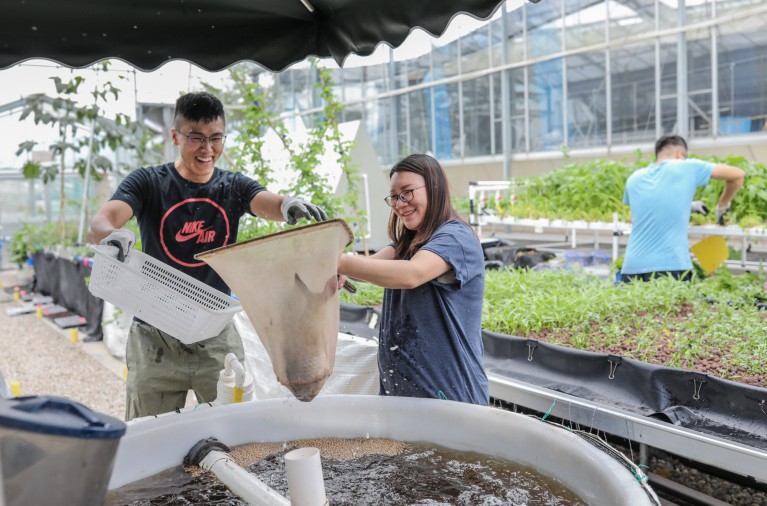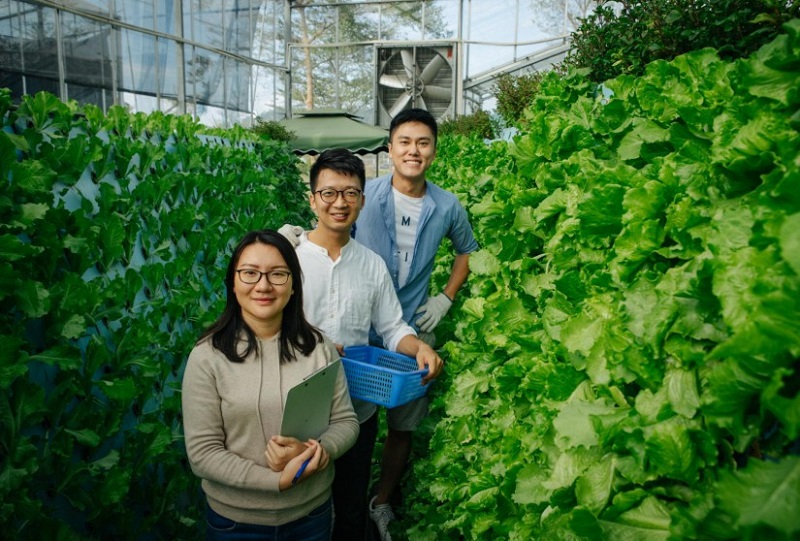A harmonious symbiosis is seen in the greenhouse of the modern agricultural demonstration base in Jiangmen City, Guangdong Province. With a dazzling range of lush hydroponic vegetables that are commonly seen on the market, such as lettuce, celery, cucumber, pumpkin, eggplant, and tomato, as well as some rare varieties, like houttuynia cordata, lemon basil, and perilla, the greenhouse is also an ideal jungle-like environment for fish raising. All this is attributed to a mechanical circulatory system, which enables water to trickle down from the hydroponic device and then be circulated between the fish pond and the pipe trough.

Victor Lo (left) and Mandy Tam catching fish from the man-made pond.
From Idea to Action
“Farming fish without changing the water and growing vegetables without fertilizer –this is the ‘fish and vegetable symbiosis’ system we have developed. It is typically a circular agricultural project,” said Fung Leung, designer of the sophisticated system, and a member of the three-person entrepreneurial team from Hong Kong. According to Leung, the “fish and vegetable symbiosis” system can transform the nutrient-rich water produced by intensive fish farming into nutrients that vegetables are able to absorb through a water treatment system, which can boost the growth of organic hydroponic vegetables. “All the vegetables grown in the greenhouse have a zero pesticide residue, because once pesticides and fertilizers are used, the fish will die,” he added.
Such an environmentally friendly high-tech agricultural project was actually created by three post-90s young people from Hong Kong - Victor Lo, Fung Leung, and Mandy Tam, who graduated from the Chinese University of Hong Kong, the Hong Kong Polytechnic University, and Hong Kong Shue Yan University respectively. They were previously classmates at Hong Kong’s Island School. It was during their senior year on campus that they came up with the idea of the “fish and vegetable symbiosis” system spurred on by their social practice task. In the entrepreneurial team, each of them has played an essential role in realizing their dream: Tam raises fish, Lo grows vegetables, and Leung designs and operates the water circulation system.

The three post-90s founders take a group photo in the vegetable greenhouse.
Further Expansion
“In 2014, in order to design this organic planting system and put it into practice, we opened a rooftop farm in Hong Kong. However, along with not being able to expand our farm, the limited space also prevented us from carrying out more experiments,” Leung said. In 2016, they began looking for agricultural parks in the mainland. After visiting several cities within the Guangdong-Hong Kong-Macao Greater Bay Area (Greater Bay Area in short), they finally found the Jiangmen’s modern agriculture demonstration base, where the local agriculture authorities gave them a helping hand, providing them with a greenhouse of 200 square meters for free, as well as RMB 50,000 allocated from the local “mayor’s fund” to start an entrepreneurial business.
“Jiangmen is an agricultural city with an advantageous geographical environment, advanced facilities, and a complete agricultural industry chain,” said Leung, who then added that they have also learned a lot from local technicians about vegetable planting.
According to Liang, “fish and vegetable symbiosis” is the frontier technology of modern agricultural production, which features a green, organic, and ecological cycle, high yields, and low energy consumption. Although the technology has been studied in the United States and Australia, foreign scientific research and practices cannot be effectively applied in China, due to the differences in the geographical environment, climatic conditions, and planting and breeding species of these different countries.
To collect data and make the circular agricultural project more suitable for China, the three-person entrepreneurial team turned back on opportunities in Hong Kong, and devoted all their time and energy to building a greenhouse in Jiangmen. Every day, they busied themselves with raising fish and vegetables, doing research, and writing reports. These efforts finally led them to ground-breaking achievements. Over the past five years, the team has collected more than 5,100 sets of water quality data, cultivated more than 220 varieties of vegetable, and applied for four national invention patents and three national utility model patents. The project has not only filled the blank in the basic application data about “fish and vegetable symbiosis” technology in south China, but also established a production system with completely independent intellectual property rights, laying a scientific foundation for the domestic industrialization of the “fish and vegetable symbiosis.”
Greater Opportunities
“We have witnessed the development of Jiangmen and even the entire Greater Bay Area over the past five years,” said Leung, and then added, “The transportation is more convenient and the exchanges between the mainland and Hong Kong and Macau are more frequent. This helps reduce our transportation costs.” When their project officially landed in Jiangmen in 2019, Leung’s team had already built an 8,000-square-meter smart greenhouse with an annual output of 400 tons of vegetables. Moreover, they have opened another modern agricultural base covering an area of 70 acres in Chikan Town of Kaiping, a county-level city in Jiangmen, with an annual output of 8,800 tons. Today, the vegetables are selling well in Hong Kong, as well as many cities like Zhuhai and Zhongshan in the Greater Bay Area.
“Food safety is the greatest concern of urban residents who are pursuing a quality life. Vegetables supplied to Hong Kong from the mainland must meet high standards throughout the whole process of production and processing. Meanwhile, Hong Kong’s agriculture itself has a weak development foundation which cannot satisfy such a large-scale and high-quality demand,” Tam said. It is because of this huge business market that this team of three young people have decided to be engaged in the cultivation of organic vegetables.
“Each city in the Greater Bay Area has its own characteristics. Jiangmen has the advantages in land and manpower with a complete agricultural industry chain, while Hong Kong has a very strong financing capacity and a demand for high-quality vegetables,” Leung said. The coordinated development and in-depth cooperation among cities in the Greater Bay Area, as well as the establishment of a mechanism to encourage entrepreneurial innovation, have made them even more optimistic about the future. “The bigger you think, the better you create. In the Greater Bay Area, what seems impossible today will become something possible tomorrow,” Leung said with confidence.